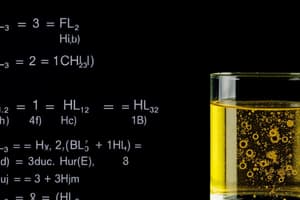Podcast
Questions and Answers
What is the purpose of the arrow in a chemical equation?
What is the purpose of the arrow in a chemical equation?
- To show the stoichiometric coefficients
- To indicate the direction of the reaction (correct)
- To separate the reactants and products
- To indicate the chemical formulas
What do the coefficients next to the symbols and formulas represent in a chemical equation?
What do the coefficients next to the symbols and formulas represent in a chemical equation?
- The number of atoms in the substance
- The phase of matter of the substance
- The absolute values of the stoichiometric numbers (correct)
- The molar mass of the substance
How are multiple substances on any side of a chemical equation separated?
How are multiple substances on any side of a chemical equation separated?
- By a plus sign (correct)
- By a minus sign
- By a comma
- By an equal sign
What is specified by a chemical formula in a chemical equation?
What is specified by a chemical formula in a chemical equation?
What was the first year when a chemical equation was diagrammed?
What was the first year when a chemical equation was diagrammed?
Flashcards are hidden until you start studying
Study Notes
Chemical Equations
- The arrow in a chemical equation indicates the direction of the reaction, with the reactants on the left and the products on the right.
- Coefficients next to the symbols and formulas in a chemical equation represent the number of molecules or formula units of each reactant or product.
- Multiple substances on any side of a chemical equation are separated by a plus sign (+).
- A chemical formula in a chemical equation specifies the type and number of atoms of each element in a compound.
- The first recorded chemical equation was diagrammed by French chemist Jean Beguin in 1615.
Studying That Suits You
Use AI to generate personalized quizzes and flashcards to suit your learning preferences.




